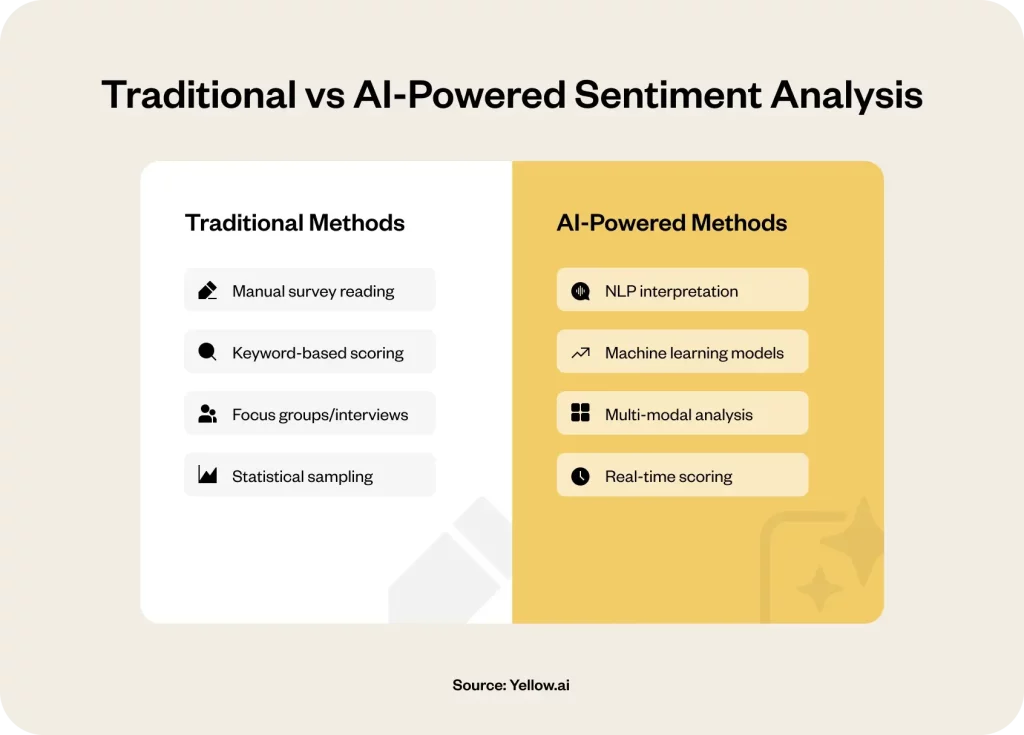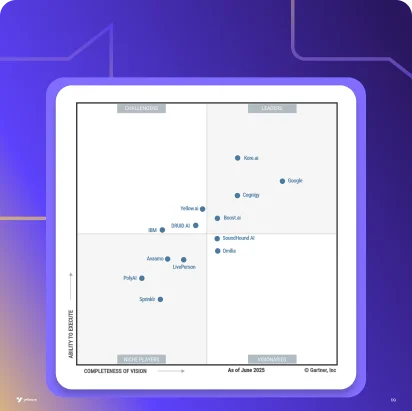Introduction: Why Sentiment Matters More Than Ever
The gap between what companies think customers feel and what they actually experience is always growing, and that disconnect is more than a missed insight; it’s a risk to revenue, retention, and reputation. In a world where customers are able to interact across chat, voice, email, and social, often within a single journey, guesswork no longer cuts it.
As omnichannel and AI-powered service models become the new norm, enterprises are turning to customer sentiment analysis to decode real-time emotion, uncover hidden friction, and respond with precision. This guide unpacks what sentiment analysis is, how it works, and why leading organizations are making it central to how they design, measure, and scale customer experience.
What Is Customer Sentiment Analysis and How Does it Work?
Customer sentiment analysis uses Natural Language Processing (NLP) and Machine Learning (ML) to interpret emotional tone in customer interactions across channels like chat, voice, email, and social media. It goes beyond simply tagging feedback as positive, negative, or neutral, it helps uncover the why behind each emotion.
By analyzing context, intent, and language patterns, sentiment tools detect nuanced emotions like frustration or satisfaction and surface insights that guide real-time responses and long-term CX strategy. As a core capability within customer analytics, sentiment analysis enables businesses to reduce churn, personalize experiences, and deliver smarter, more empathetic support at scale.
Why Sentiment Analysis Is Business-Critical in 2025
Emotional Intelligence at Scale
As customer expectations continue to rise, enterprises are expected to deliver empathy, not just efficiency, across every interaction. But emotional intelligence doesn’t scale easily with just human teams alone. Sentiment analysis fills that gap by using AI to detect tone, mood, and intent in real time across channels like chat, voice, and email. It enables systems to recognize frustration before it escalates or acknowledge satisfaction in the moment, allowing brands to tailor responses with empathy at scale. This shift turns customer interactions from transactional to relational, without inflating headcount or compromising consistency.
| Business Impact | With AI Sentiment Analysis | Without Sentiment Analysis |
|---|---|---|
| Escalation Management | Real-time alerts, 40% faster resolution | Manual review, delayed response |
| Customer Recovery | Proactive intervention, 25% higher retention | Reactive damage control |
| Operational Efficiency | Prioritized workflows, 30% cost reduction | Generic queues, resource waste |
| CX Metrics | 15-20% CSAT improvement | Flat or declining satisfaction |
| Risk Mitigation | Early churn detection | Customer loss without warning |
1. From Gut Feeling to Data-Driven Action
73% of customers expect brands to understand their unique needs. Sentiment analysis replaces assumptions with real-time insights, helping teams respond faster and more accurately, based on how customers actually feel, not just what they say.
2. A Competitive Edge in CX Delivery
Companies using real-time sentiment analysis are 2.4x more likely to exceed customer satisfaction goals. Why? Because in CX, how an issue is handled often matters more than what gets resolved. Emotion-aware responses build trust where scripts can fall short.

Traditional vs. AI-Powered Sentiment Analysis
Not all sentiment analysis solutions are created equal. While Traditional methods rely heavily on manual effort and basic keyword matching, often missing nuance and scale, AI-powered approaches on the other hand bring speed, consistency, and deeper emotional understanding to every interaction.
Traditional Methods
- Manual Survey Reading – Human analysts read through surveys, categorize them by sentiment, and draw conclusions. This method, while insightful for small samples, becomes inefficient and inconsistent at scale.
- Keyword-Based Scoring – Early sentiment tools relied on matching keywords like “great” or “bad.” But without understanding context or sarcasm, this often led to misleading results.
- Focus Groups and Interviews – Valuable for deep qualitative insights, but limited in scale and often subject to participant bias.
- Statistical Sampling – Sentiment was inferred from small sample sizes, assuming they reflected broader trends. This is risky when dealing with large or diverse customer bases.
AI-Driven Methods
- Natural Language Processing (NLP) – AI models process language the way humans do, picking up on nuances, sarcasm, and emotional cues in context, not just keywords.
- Machine Learning Models – These systems improve over time by learning from past customer interactions, becoming more accurate and contextual with every dataset.
- Multi-Modal Analysis – Going beyond text, AI can analyze voice tone, sentiment in speech patterns, and even facial expressions in video thus providing a holistic emotional profile.
- Real-Time Processing – Modern tools offer near-instantaneous sentiment scoring, allowing agents or bots to intervene in the moment.
- Contextual Understanding – AI considers the entire customer journey, previous conversations, and tone shifts, not just isolated messages.
| Capability | Traditional Methods | AI-Powered Methods | Enterprise Impact |
|---|---|---|---|
| Scale | Limited (hundreds) | Unlimited (millions) | Supports global operations |
| Speed | Days to weeks | Real-time to minutes | Enables immediate intervention |
| Accuracy | 60-70% (subjective) | 85-95% (trained models) | Reduces false positives |
| Cost per Analysis | $5-15 per interaction | $0.01-0.10 per interaction | Massive scale economics |
| Integration | Manual export/import | API-driven automation | Fits enterprise tech stack |
| Compliance | Manual audit trails | Automated documentation | Meets regulatory requirements |
Key Advantages To Look Out For:
- Scale and Speed – AI-powered tools can process millions of conversations simultaneously. This unlocks operational efficiency, reduces delay in detecting issues, and ensures that no interaction slips through the cracks.
- Consistency and Accuracy – Unlike human analysts who may tire or interpret sentiment differently, AI applies consistent rules across every interaction, resulting in more reliable insights.
- Advanced Capabilities – AI can go far beyond simple positive/negative categorization. It recognizes nuanced emotions like frustration, relief, confusion, or delight, and scores their intensity.
- Predictive Insights – AI doesn’t just observe what happened. It helps predict what will happen, like which customers are at risk of churning based on their emotional journey.
Real-Time vs. Post-Interaction: Timing Is Everything
Real-time sentiment analysis helps you respond in the moment, adjusting live chats, routing angry customers, or triggering instant recovery workflows. Post-interaction analysis helps you learn from the past. The main focus here lies on spotting patterns, equipping teams with targeted upskilling based on sentiment trends, and improving processes based on aggregated emotional insights. Together, they form a closed-loop system for proactive and strategic customer experience management including an efficient and smooth customer service experience that builds brand trust and loyalty.
Real-Time Sentiment Analysis
| Step | Example | Use Case |
|---|---|---|
| Live chat tone detection | “This is so annoying.” | Escalate to senior agent |
| Voice tone alerts | Frustration in IVR detected | Offer human fallback |
| Real-time workflows | Negative trigger phrase in WhatsApp | Route to bot with apology + resolution flow |
| Sentiment-based routing | Angry ticket flagged in CRM | Prioritized queue assignment |
Post-Interaction Analysis
| Step | Example | Use Case |
|---|---|---|
| Survey feedback analysis | “Great app, but checkout was buggy” | Flagged for product team |
| Call transcription scoring | Passive tone + repeated complaints | Agent coaching intervention |
| Weekly CX trends | Drop in sentiment post-update | Correlate with churn spike |
Pro Tip – Enterprises that combine real-time and post-interaction sentiment insights outperform siloed teams. Use real-time for frontline interventions, and post-interaction for CX strategy.
Common Mistakes to Avoid
- Overly relying on CSAT – CSAT scores offer a narrow, after-the-fact snapshot of customer experience, often missing the emotion behind the rating. A “3 out of 5” tells you something was off, but not the reason behind it. Sentiment analysis fills that gap by capturing emotion throughout the customer journey, not just at the end, giving teams a more accurate and proactive view of customer satisfaction.
- Ignoring important customer context – Language is very nuanced and sentiment can shift with tone, timing, or channel. A phrase like “It’s fine” might signal frustration in a support chat or satisfaction in a review. Without analyzing context properly, like conversation history, escalation paths, or prior interactions, businesses can risk misreading sentiment and responding inappropriately to the customer.
- Not closing the loop – Gathering sentiment insights is only half the job, what matters the most is acting on them. If negative sentiment is flagged but no workflow is triggered (like escalation, follow-up, or recovery), the value of that insight is considered to be lost. Leading teams embed sentiment-driven triggers directly into their CX systems to ensure real-time feedback leads to real-time action.
- Treating all feedback equally – Not every piece of feedback deserves the same level of attention. High-intensity negative sentiment from a top-tier customer is far more urgent than mild dissatisfaction from a low-value segment. Smart sentiment analysis weighs both emotion and customer value and helps teams align response priority with sentiment severity and customer lifetime value.
Customer Sentiment Analysis ROI: Use Cases Across Enterprise Functions
From support to retention, Sentiment Analysis drives measurable ROI by turning emotion into actionable intelligence across the customer journey.
Customer Support
- Dynamic tone based routing – Identify frustration or urgency mid-conversation and automatically escalating it to senior agents leads to reducing resolution time and improving customer satisfaction.
- Identify agent training needs – Spotting consistent negative sentiment in agent interactions to tailor coaching on empathy, tone, or product knowledge.
Marketing
- Optimizing campaign messaging – Analyze real-time sentiment across social, email, and chat to understand what messaging resonates and accordingly adjust campaigns on the fly.
- Gauge sentiment by audience segment – Break down emotional response by region, persona, or product to better personalize offers and improve ROI.
Product + CX Teams
- Identify UX friction from support tickets – High concentrations of negative sentiment tied to specific features or flows reveal usability pain points before they can show up in NPS scores.
- Focus on what drives the strongest emotional reactions and business outcomes – Emphasise on roadmap efforts on issues that not only appear often, but also evoke strong negative sentiment.
Retention + Loyalty
- Spot at-risk accounts through sentiment patterns – Identify churn risk early by detecting emotional decline across repeated high-value interactions.
- Trigger win-back workflows – Activate automated recovery actions, like callback offers or discounts, based on sentiment and customer value.
Real-World Examples
- Retail – A surge in post-checkout complaints revealed payment friction. Sentiment analysis helped pinpoint the issue, resulting in a frictionless checkout experience and improved conversion.
- Telecom – A real-time voice call flagged as high-risk allowed the agent to shift tone and de-escalate, resulting in a successful retention.
- Banking – NPS verbatim from a top-tier client were flagged for executive attention, leading to a personalized outreach and recovery.
How Yellow.ai Delivers Sentiment Intelligence at Scale
Yellow.ai’s Analyze module equips enterprises with actionable sentiment insights embedded directly into their CX operations, no siloed dashboards or delayed reports.
- Real-time monitoring: Detects tone shifts during live conversations across chat and voice to enable immediate, emotion-aware interventions.
- Omnichannel intelligence: Consolidate sentiment trends across WhatsApp, webchat, email, and more, so nothing slips through the cracks.
- Operational triggers: Flag high-risk interactions, benchmark empathy, and activate automated workflows that close the loop fast.
Customer Highlight – IKEA Indonesia leveraged Yellow.ai to achieve 98% accuracy and 73% containment while proactively detecting emotional dips that required human intervention.
Related Read – Contact Center Analytics
How to Implement Customer Sentiment Analysis: Enterprise Getting Started Guide
You can’t improve what you don’t understand. Sentiment analysis gives you the visibility to act. Whether it’s prioritizing critical customer issues, coaching teams for empathy, or spotting churn before it happens, the value lies in turning emotional signals into operational decisions.
Next Steps for Enterprise CX Teams:
- Benchmark your sentiment visibility – Start by auditing where and how you’re capturing sentiment today. Are you analyzing only surveys, or also chats, calls, and social interactions? Identify coverage gaps and channels lacking emotional insight.
- Identify emotional hotspots – Pinpoint high-volume, high-stakes moments in the customer journey, billing issues, support escalations, product returns, where sentiment tends to spike. These are the inflection points where proactive intervention pays off.
- Deploy sentiment analysis where it matters most – Don’t aim for blanket coverage, prioritize use cases with the highest impact on satisfaction, retention, or brand perception. Use AI-driven analysis to enable real-time triggers, post-interaction reviews, and continuous improvement.
Successful enterprise sentiment analysis requires more than technology, it demands strategic planning, organizational alignment, and careful change management. CX leaders facing complex implementation decisions benefit from consulting with specialists who understand both the technical and business transformation aspects.
[Request a Consultation with Our Implementation Specialists]
Frequently Asked Questions (FAQ’s)
What are sentiment analysis tools?
Tools that use AI and NLP to automatically detect emotions and opinions in customer communication.
Can sentiment analysis improve customer experience?
Yes. It helps brands personalize interactions, prioritize responses, and proactively reduce friction.
How is sentiment analysis used in marketing?
Marketers use it to assess brand health, campaign effectiveness, and public response to messaging./
What are some examples of customer sentiment analysis?
Examples include tagging survey comments by tone, flagging angrya calls for escalation, or analyzing social media chatter post-launch.quo





















